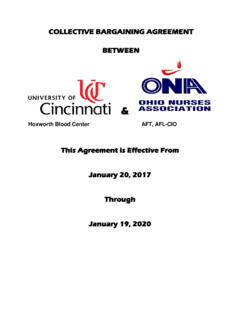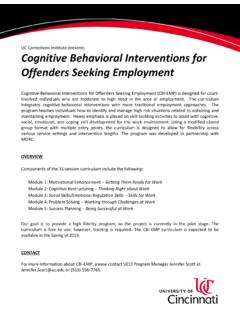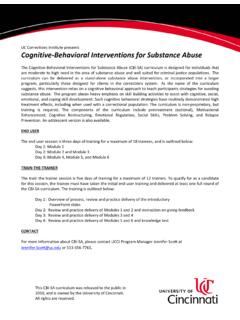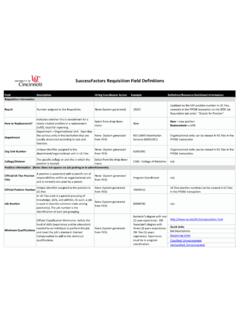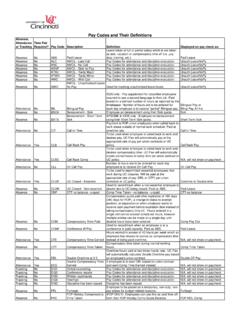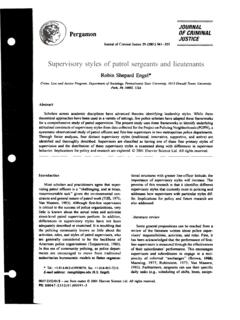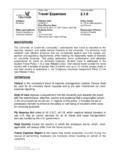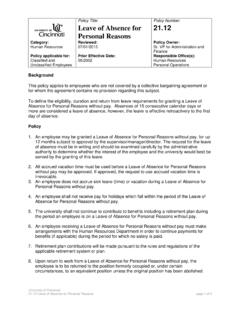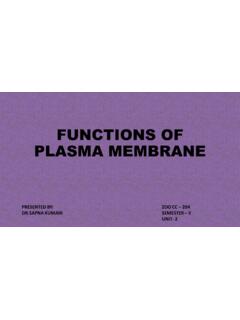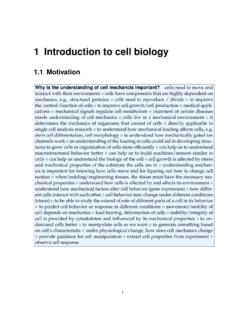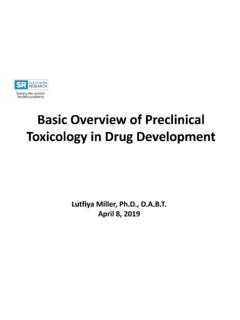Transcription of The Body’s Transport System
1 THE CIRCULATORY SYSTEMThe Body s Transport SystemCOMPILED BY HOWIE BAUMT hecirculatorysystem,sometimescalledtheca rdiovascularsystem,consistsoftheheart,bl oodvessels, , "muscle" System circulates blood in two circuits:The Pulmonary circuit and Systemic CIRCULATION1)Pulmonary circulationTransports oxygen-poor blood from the right ventricle to the lungs where blood picks up a new oxygen supply. Heart: your heart pumps blood through two major CIRCULATION2) Systemic circulationIt returns oxygen rich blood and nutrients to the left atrium and is pumped out all over the bodyIt also picks up carbon dioxide and other waste products. Hormonesfrom glands help regulate cell activity. Oxygenfrom the lungs combines with nutrients to provide energy.
2 Nutrientsfrom the digestive System provide food for the blood enters the heart from the lungs (red, right side) and is pumped out to the body (top) Oxygen-poor blood enters the heart from the body (blue, top left) and is pumped out to the lungs (blue, top right) CIRCULATORY System WORKS IN CONJUNCTION WITH OTHER BODY SYSTEMS, TO KEEP THE IT WORKING PROPERLY. Whenyourbloodcirculatesthroughyourdigest ivesystem,itpicksupnutrientsyourbodyabso rbedfromyourlastmeal. ,includingcarbondioxide,anddeliversthese wasteproductstothekidneysandlungsfordisp osal. Thecirculatorysystemcarrieshormonesfromt heendocrinesystem,andtheimmunesystem swhitebloodcellsthatfightoffinfection. Thecirculatorysystemprovidesyourbrainwit haconstantsupplyofoxygen-richbloodwhiley ourbrainregulatesyourheartrateandbloodpr essure.
3 , VESSELS -Over 60,000 miles of blood vessels Transport your blood throughout your body. There are 3 types of blood vessels. Arteries: Blood vessels that carry blood away from the heart to other parts of the body. They are much thicker than Veins because of the high pressure of blood coming from the heart. Veins: Blood vessels that carry blood from the body back to the heart. Capillaries:Tiny tubes that carry blood from the arteries to the body s cells , and then back to the Body tissues contain a vast network of thin capillaries. Capillary walls are only one cell thick, allowing exchange of gases, nutrients, and wastes. Capillaries are so fine that red blood cells must line up single-file to go through , VEINS, AND CAPILLARIES BLOODB lood forms about one-twelfth of the body weight of an adult, amounting to about 5 liters (11 pints) in volume.
4 45% 50% is red Blood CellsRoughly 50 55 % of blood is plasma, the liquid-only portion in which cellular components are distributed. Plasma contains 90 per cent water with dissolved substances such as glucose (blood sugar), hormones, enzymes, and also waste products such as urea and lactic acid. Plasma also contains proteins such as albumin, fibrinogen (important in clotting), and globular proteins or BLOOD cells (ERYTHROCYTES) They are Transporters of Oxygen Carbon Dioxide Red Blood cells Lack a nucleus Contain hemoglobin Disk-shaped They are produced in red bone marrow of the: ribs Humerus(upper arm bone) Femur (upper leg bone) sternum, and other long bones They live for 120 days Old red blood cells are destroyed in the liver and spleenTheir shape is described as Bio-Concave as they have depressions on both sides, so they have a maximum amount of surface to absorb oxygen from the lungsWHITE BLOOD cells White blood cells defend against disease by recognizing proteins that do not belong to the body.
5 They are able to ooze through the walls of capillaries to patrol the tissues and reach the lymph Platelets are cell fragments used in blood clotting. They are derived from megakaryocites. Because they lack a nucleus, platelets have a short lifespan, usually about 10 4 BLOOD TYPEST here are four blood types. A, B , AB, and O. +, +, +, +, O-~ All blood has a Rh~ The Rh determined the blood Rhesus (Rh) factor is an inherited protein found on the surface of red bloodcells. If your bloodhas the protein, you're Rhpositive. If your bloodlacks the protein, you're Rhnegative. Rhpositive is the most common DO MOSQUITOES LIKE ME ?Do you find that mosquitoes and other biting insects choose you, rather than other people ?
6 Did you ever wonder why ?If you have Type O blood, they prefer you twice as much, than others, who have Type A !! People with Type B, fall in the middle of these 20 percent of people, it turns out, are especially delicious for mosquitoes, and get bit more often on a consistent basisBLOOD PRESSUREAs blood is moved through your body, it exerts pressure against the walls of blood vessels. Systolic Pressure: as your heart contracts to push blood into your arteries, your blood pressure is at its highest point. Diastolic Pressure: As your heart relaxes to refill, blood pressure is at its lowest is an electrical System inside your heart that controls the rate (speed) and rhythm of your heart. A normal heart rhythm is called normal sinus rhythm (NSR).
7 When there is a problem with your heart rhythm or rate, it is called heart s electrical System It starts with an electrical signal in the right atrium, at the SA Node (sinoatrial node). The electrical signal then spreads throughout the heart from top to bottom (from atria to ventricles). As one part contracts, the others relax in a IS AN ECG OR AN EKG? -An electrocardiogram (ECG or EKG) is a test that checks how your heart is functioning by measuring the electrical activity of the heart. With each heartbeat, an electrical impulse (or wave) travels through your heart. This wave causes the muscle to squeeze and pump blood from the ECG measures and records the electrical activity that passes through the heart. A doctor can determine if this electrical activity is normal or , BALLOON ANGIOPLASTY, AND STENTSYour heart s arteries can become blocked or narrowed from a buildup of cholesterol, cells or other substances (plaque) which can reduce blood flow to your heart and cause chest discomfort.
8 Angioplasty opens blocked arteries and restores normal blood flow to your heart muscle. It is not major surgery. It is done by threading a catheter (thin tube) through a small puncture in a leg or arm artery to the heart. The blocked artery is opened by inflating a tiny balloon in pacemaker is a battery-operated device placed in the body to produce electrical pulses that cause the heart to beat at a normal rate. Over the last 60 years, the size of Pacemakers have been reduced a S SMALLEST PACEMAKERM edtronic s Micra Pacemaker was approved by the FDA for use in the United States on April 6, 2016. This tiny device is implanted inside the patient s heart and small tines then attach to the heart wall. It is 93% smaller than conventional pacemakers, and about the size of a large vitamin ,soafutureoperationisn !
9 ! , (set at .75 speed)BIOLIFE4D MINIATURE HEARTC hicago-based biotech outfit Biolife4D claims to have 3D bio-printed a miniaturized human heart chambers, ventricles, and all. The company used a proprietary bio-ink the company described it as similar in properties to gelatin that was designed from the ground up to replicate actual human biomaterials. To help with structural integrity during the printing process, Biolife4D printed an additional support scaffold encasing the problem -More than 3,200 people are on the waiting list for a heart transplant in the United States. The solution -Take a pig heart, soak it in an ingredient commonly found in shampoo and wash away the cells until you're left with a protein scaffold that is to a heart what two-by-four framing is to a inject that ghost heart, as it's called, with hundreds of millions of blood or bone-marrowstem cellsfrom a person who needs a heart transplant, place it in a bioreactor --a box with artificial lungs and tubes that pump oxygen and blood into it --and wait as the ghost heart begins to mature into a new, beating human s interesting that there are other colors of blood, than our own red.
10 The colors shown below are the real colors of various other creatures. The body of an adult contains over 60,000 miles of blood vessels! An adult's heart pumps nearly 4,000 gallons of blood each day! In one day your heart beats 100,000 times, which comes out to about 30 million times a year which is at least billiontimes during the average life span and with resting between beats ! A "heartbeat" is really the sound of the valves in the heart closing as they push blood through its chambers. Women s hearts beat faster than men s. A single drop of Blood contains 250 million red blood cells and 275,000 white blood cells !COOL FACTS ABOUT YOUR CIRCULATORY SYSTEMIn ten years, a cell will have travelled over 59,654 miles equivalent to times the distance around the earth!

